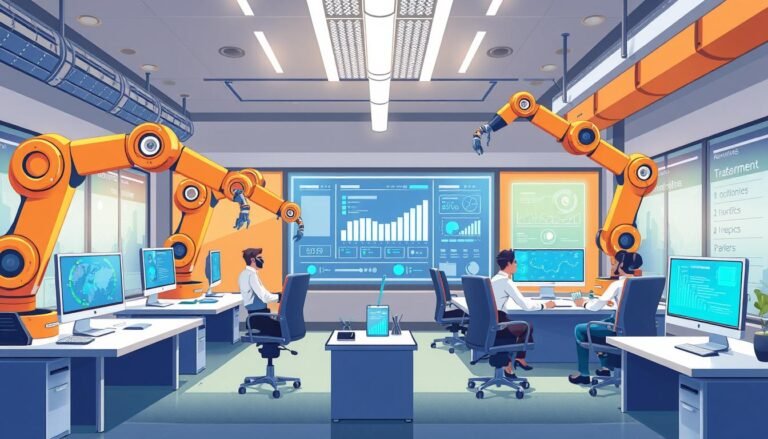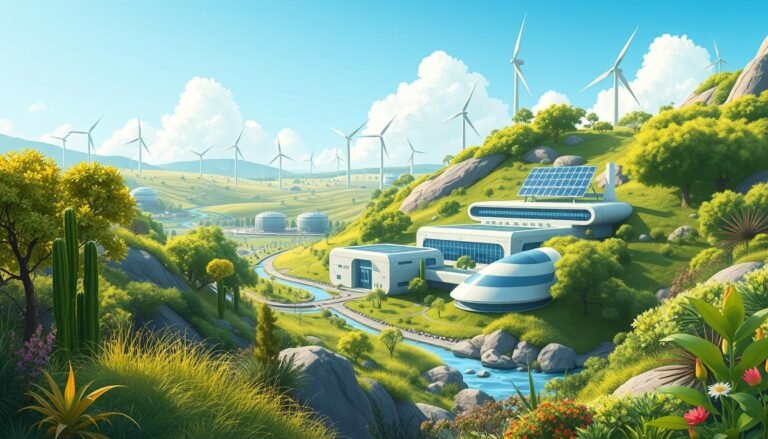The Circular Economy: Trends and Applications for Businesses
Imagine if your business could grow its profits and help the planet at the same time. The circular economy is becoming more popular among companies that want to make money and protect the environment. Old ways of doing business are being replaced by new, greener models.
These new models focus on using things over and over again. They encourage fixing, updating, and recycling products. This approach is good for both the economy and the planet.
Key Takeaways
- The circular economy revolves around eliminating waste, circulating products, and regenerating nature.
- Businesses in the EU could save up to USD 630 billion annually through circular economy practices.
- Emerging circular activities can lead to increased revenues and lower production costs.
- The circular economy model holds the potential for creating new job opportunities while maintaining environmental balance.
- Traditional linear models are being replaced as global sustainability needs intensify.
- Circular business practices help mitigate environmental impacts, operational costs, and enhance resource efficiency.
- Europe’s biosolids and residuals programs from wastewater management significantly reduce operational costs and sludge sent to landfills.
Understanding the Circular Economy
The circular economy is changing how we make and use things. With material use up by over 65 percent in 20 years, it’s key to look at new ways like the circular economy. This model aims to cut down on waste and use resources better.
What is the Circular Economy?
The circular economy is a system that wants to use resources forever without waste. It’s different from old ways that just take, make, and throw away. For example, food waste is huge, with 13 percent lost after harvesting and 17 percent wasted at home and in stores.
In a circular economy, this waste is turned into something useful. This helps the environment and supports green practices.
The Key Principles of the Circular Economy
The circular economy has three main ideas. First, it aims to get rid of waste and pollution. Second, it keeps products and materials moving in a loop. Third, it helps nature heal itself.
By following these ideas, businesses can harm the environment less. Studies say using circular economy ideas could cut greenhouse gas emissions by 40 percent by 2050. This is true for both industrial materials and food systems.
Differences Between Linear and Circular Economies
It’s important to know how linear and circular economies differ. Linear economies use up resources and make a lot of waste. On the other hand, circular economies keep using and recycling materials.
For example, in 2019, we threw away 7.3 kilograms of electronic waste per person. This is a big problem for linear systems. But, a circular approach can turn this waste into new products, saving natural resources.
Here are some key differences between linear and circular economies:
| Aspect | Linear Economy | Circular Economy |
|---|---|---|
| Resource Use | Extract-consume-dispose | Reuse, repair, recycle |
| Waste Generation | High waste levels | Minimal waste |
| Environmental Impact | High pollution | Reduced emissions and pollution |
| Economic Design | Linear, end-of-life design | Sustainable, regenerative design |
| Job Creation | Limited to production and disposal | New jobs in recycling, repair, and remanufacturing |
Switching to circular economies could create 6 million jobs worldwide by 2030. It’s a big step towards a greener future. Countries like Vanuatu and the European Union are already leading the way.
Key Trends in the Circular Economy
New trends in the circular economy are changing how we handle resources and waste. Companies are moving away from old waste disposal methods to more green options. The use of IoT and AI in waste management is making sorting more efficient and cheaper.
The sharing economy is also growing, helping products last longer by being reused and shared. This approach is good for the environment and boosts the economy. Let’s explore these important changes.
Waste-to-Resource Innovations
Recycling is key in turning waste into useful resources. For example, only a tiny fraction of old clothes are recycled into new ones. This shows a big chance for improvement.
Companies are using new recycling methods to tackle the huge amount of waste that’s currently thrown away. This is crucial for reducing food and plastic waste.
Reusing and Sharing Platforms
The sharing economy helps products last longer and cuts down on waste. People throw away a lot of still-good clothes, wasting billions of dollars. Online platforms that promote reuse and sharing can help fix this.
The fashion industry, which uses a lot of water, can also benefit from these practices. This is especially true for the 93 billion cubic meters of water it uses every year.
- ThredUp: An online consignment store that helps reduce fashion waste.
- OLIO: A food-sharing app aimed at reducing food waste within communities.
Using sharing platforms can save the FMCG sector $700 billion a year. Reusing old clothes can also reduce the need for new ones, saving resources.
IoT and AI in Waste Management
IoT and AI are changing waste management. They make sorting more efficient and lower costs. For example, AI can cut emissions by 40% in industries like cement and steel.
A report by the UN International Resource Panel shows that remanufacturing can cut emissions by up to 80%. This is crucial, especially with the growing amount of e-waste.
These advancements could create 1.8 million jobs by 2040. Recycling, the sharing economy, and AI in waste management are leading to a more sustainable and prosperous future.
| Key Metrics | Current Statistics |
|---|---|
| CO2 Emissions from Material Production by 2100 | 649 billion tonnes |
| Annual Food Waste Generation | 1.3 billion tonnes |
| Plastic Waste Production Annually | 300 million tonnes |
| Fashion Industry Water Consumption | 93 billion cubic meters |
| Reduction in Emissions via Circular Economy by 2050 | 40% |
| Annual E-Waste Discarded | 20 to 50 million metric tonnes |
Effective waste management is a critical component of sustainable business practices, particularly in the food industry where waste reduction can significantly impact environmental and economic outcomes. For businesses looking to optimize their operations and minimize waste, understanding practical strategies is essential. You can learn more about managing food waste and implementing smart techniques by visiting this detailed guide on Managing food waste, which offers actionable advice suited for commercial kitchens and food-related businesses.
The Circular Economy: Trends and Applications for Businesses
Using circular economy ideas can make businesses more sustainable and profitable. By adopting these models, companies can gain a big advantage in the market.
Adopting Circular Models in Business
Businesses use strategies like refuse, rethink, and reduce to go circular. They also reuse, repair, and recycle. This 9R framework helps make businesses more efficient with resources.
The construction industry, for example, uses a lot of materials. By going circular, it could save over $100 billion a year.
Benefits of Circular Economy for Businesses
Going circular can save costs and improve a brand’s image. It also helps meet stricter environmental rules. Plus, it opens up new markets for sustainable products.
It also creates new jobs and skills in industries like construction. This is through upcycling materials.
Examples of Successful Implementations
Companies like Unilever and Patagonia have made circular practices work. Unilever focuses on sustainable sourcing and reducing waste. Patagonia recycles and repurposes materials for eco-friendly products.
These examples show that going circular is good for the planet and the wallet. It supports both environmental and economic goals.
| Company | Strategies Implemented | Benefits Realized |
|---|---|---|
| Unilever | Sustainable sourcing, waste reduction | Cost savings, improved brand image |
| Patagonia | Recycling, repurposing materials | Enhanced sustainability, increased market share |
These cases show the power of circular economy ideas. They bring economic benefits and support sustainable growth.
Technological Innovations Driving the Circular Economy
Technological advancements are key to the circular economy. They help businesses make products last longer and recycle more efficiently. In 2020, only 8.6% of the global economy was circular, down from 9.1% in 2018. This makes the need for a circular economy more urgent than ever.
The European Union and China have set plans to boost this effort. Their plans show the world’s commitment to circular practices.
Biodegradable materials are a big step forward. They make recycling easier and cut down on environmental harm. Companies like IKEA and The Body Shop are leading the way by using these materials.
Digital technologies like IoT, Machine Learning, and AI are also changing things. They help track materials better, sticking to circular economy rules. For example, Unilever’s use of refill stations and digital kiosks shows how tech can improve product management.
In the equipment world, new tech is key for green maintenance. It uses real-time data for predictive maintenance. This cuts down waste and boosts productivity and profits.
Platforms like Annata 365 help manage data and follow circular economy rules. This is crucial for companies.
Industries that use closed-loop systems save a lot of energy. They also keep more value in existing products. Nike’s work with over 32 million sports shoes shows how tech can help the environment.
Digitalization is vital in the equipment industry. Old ways can waste data, but new tech can make things better. Since 2016, there’s been a lot of research on digital tech for circular economies.
In summary, advanced technology is crucial for growing the circular economy. It helps with recycling and sustainable maintenance. This ensures businesses can move towards more sustainable, closed-loop systems.
Case Studies: Companies Leading the Circular Economy
The circular economy is becoming more popular worldwide. Many companies are showing how to be more sustainable. We’ll look at Nike, The Body Shop, and SEaB Energy to see how they’re leading the way.
Nike is working hard to reduce waste and use it in new ways. They have recycling programs that make products from old materials. This shows how they’re making a difference for the planet.
The Body Shop is also making big changes. They’re working on packaging and product design to be more eco-friendly. They even have refill stations and a recycling program to help the environment.
SEaB Energy is turning food waste into energy. They use anaerobic digestion to make renewable energy. This shows how waste can be turned into something useful.
These companies show that going circular is possible and beneficial. A 2024 study found that using bio-based and recyclable materials is becoming more common. This is a big step towards a more sustainable future.
| Company | Key Initiatives | Impact | Sector Focus |
|---|---|---|---|
| Nike | Grind program, recycling initiatives | Reduced waste, sustainable products | Fashion, Manufacturing |
| The Body Shop | Refill stations, recycling programs | Zero-waste, sustainable packaging | Retail, Packaging |
| SEaB Energy | Anaerobic digestion, waste-to-energy | Renewable energy from waste | Energy, Waste Management |
These companies are showing the way to a more circular economy. Their success can inspire others to follow their lead.
Conclusion
The circular economy is a key to a sustainable future. It brings many benefits for the environment, economy, and society. Companies and governments are starting to adopt this model, which looks promising for reaching our sustainability goals.
Brands like Nike, Ikea, and H&M are leading the way. They show how circular practices can greatly reduce waste and make better use of resources. Nike’s “Move to Zero” program, for example, works with the Olympics to cut down on waste and use eco-friendly materials.
Ikea’s program lets customers return used furniture, helping to make the world more sustainable. H&M’s “Closing the Loop” initiative aims to reduce waste and use resources more efficiently. This shows how the circular economy can positively impact industries like fashion.
Other big names like HP, Adidas, and Patagonia are also making changes. They use recycled materials, like ocean-bound plastics, and support ecosystem restoration. Siemens shows how businesses can lessen their environmental footprint with smart data-driven decisions.
As companies move towards circular models, teamwork between academia and industry is crucial. Research in sustainable supply chains and business models will help us understand and apply the circular economy better. Together, we can unlock the full potential of the circular economy and meet global sustainability goals.
Source Links
- The circular economy in detail
- The Circular Economy
- Sustainability and the Circular Economy Business Development
- What is circular economy and why does it matter? | UNDP Climate Promise
- The Circular Economy: Trends, Challenges, and Solutions
- Infographic – Top trends in the circular economy – ScaleX
- 2024 Circular Economy Trends: 6 Key Legislations
- EESE11016005.pdf
- Top 8 Circular Economy Trends in 2025 | StartUs Insights
- Research trends in innovation ecosystem and circular economy – Discover Sustainability
- Driving Circular Economy through Digital Technologies: Current Research Status and Future Directions
- Brands Pioneering Circular Economy Innovation
- Leveraging technology towards a circular economy – Annata Management Solutions
- 10 Leading Circular Economy Examples in 2024 | StartUs Insights
- These 10 companies excel at marrying net-zero and circular economy goals | Trellis
- Proceedings Template – WORD
- Sustainability Blogs
- A bibliometric analysis of circular economy in the fields of business and economics: towards more action-oriented research








